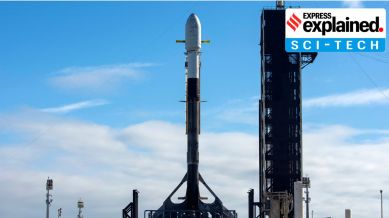Connecting people from the moon? Behind NASA’s bid to put a lunar Nokia cellular network
While the ten-day IM-2 mission is primarily focused on mining for precious resources on the far side of the moon, it will also attempt to deploy the first lunar surface cellular network. Here is what to know.

A year after Intuitive Machines became the first private company to land on the moon, it launched its second mission from NASA’s Kennedy Space Center in Florida on Wednesday (February 26) evening.
The Athena moon lander, built by Intuitive Machines, has since detached from the SpaceX Falcon 9 rocket it was attached to, and is expected to reach the moon on March 6.
While the ten-day IM-2 mission is primarily focused on mining for precious resources on the far side of the moon, it will also attempt to deploy the first lunar surface cellular network.
The mobile network was developed as a partnership between NASA and Finnish telecom company Nokia. Here is what to know.
https://twitter.com/NASA/status/1894905624326029791
Lunar cellular connectivity
Until now, the mode of communication from the moon has been via radio waves, with a clear line of sight needed between transmitting antennas on the lunar surface and the receiving antennas on Earth. This is not feasible on the far side of the moon, the lunar surface which never faces Earth.
Building a lunar communications network that allows for real-time viewing of high-resolution video and science data is critical to NASA’s Artemis programme, which aims to return astronauts to the moon before 2030.
Cellular technology was thus mooted as an alternative, and Nokia Bell Labs was awarded a contract by NASA in 2020 to create an “ultra-compact, low-power, space-hardened, end-to-end LTE solution”, according to a company press release.
In February 2023, Nokia identified one of its primary goals on the IM-2 mission as proving that “the same cellular technologies used to connect our smartphones on Earth can be used to provide communications and critical connectivity for future lunar missions.” However, given the harsh conditions of space travel and on the moon, these components would need to be repurposed for lunar use. That July, Nokia announced it had partnered with Intuitive Machines to this effect.
This January, Nokia announced that it had fully integrated its Lunar Surface Communication System (LSCS) into the Athena lander. The LSCS will reportedly use the 4G/LTE technology widely used on Earth. The network was favoured by Nokia for being “well-established in terrestrial networks”, its “excellent performance and economies of scale”, and for offering a “well-defined path to 5G.”
The LSCS comprises two device modules – a lunar rover and a hopper. Once Athena makes its landing, these devices will attempt to connect to its cellular network while exploring the lunar surface. Athena will also be connected to the Earth, enabling high-definition video streaming and command and control operations, Nokia said.
The LSCS is designed to fit all the components in a single “network in a box” except for the antenna and a power source. “We have the antenna on the lander, so together with the box that’s essentially your base station and your tower”, Thierry Klein, president of Nokia Bell Labs Solutions Research, told MIT Technology Review. The box will be powered by the lander’s solar panels.
The 4G cell network is expected to work only for a few days on the IM-2 mission.
What to know about the IM-2 Mission
The Texas-based Intuitive Machines became the first private company to complete a successful moon landing last February, carrying six NASA payloads, including one at the moon’s south pole.
Its second mission, IM-2, is part of the NASA Commercial Lunar Payload Services Programme, designed to support private sector-led moon landings. IM-2 intends to build on its 2024 success and land on Mons Mouton, a mountain at the moon’s south pole.
The moon’s south pole has been of interest to space agencies worldwide as it is believed to contain ice and rare minerals, seen as crucial for further space exploration. The IM-2 will explore this in part, deploying a pair of NASA instruments which will drill three feet into the lunar surface to specifically look for water and carbon dioxide. The presence of water could help to establish a permanent lunar base, or at least assist manned missions to the moon.